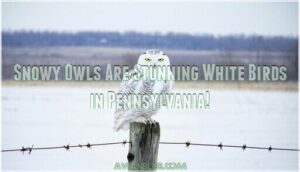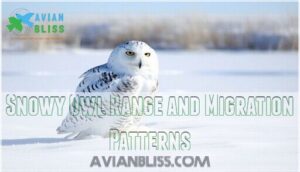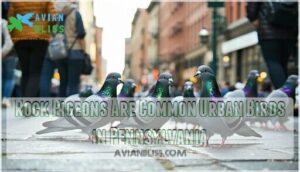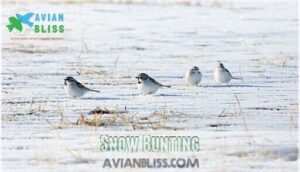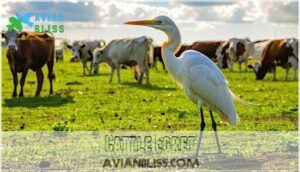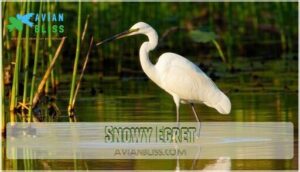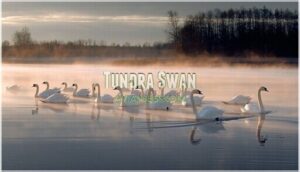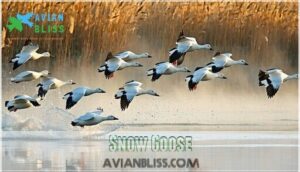This site is supported by our readers. We may earn a commission, at no cost to you, if you purchase through links.

Majestic snowy owls migrate here in winter, their white feathers blending beautifully with snow-covered fields.
Great egrets and snowy egrets grace wetlands with their sleek white plumage and patient hunting.
Along rivers and lakes, you’ll see tundra swans and trumpeter swans, both huge and impressive, especially during migration.
Ring-billed gulls are common water birds, often seen near the state’s reservoirs.
Even urban areas have rock pigeons, familiar yet remarkable in their adaptability.
Each species tells a unique story, with more surprises waiting in Pennsylvania’s incredible natural landscapes.
Table Of Contents
- Key Takeaways
- Snowy Owl
- Rock Pigeon
- Snow Bunting
- Ring-Billed Gull
- Great Egret
- Cattle Egret
- Snowy Egret
- Tundra Swan
- Trumpeter Swan
- Snow Goose
- Frequently Asked Questions (FAQs)
- What is the largest bird of prey in Pennsylvania?
- What are the top 5 largest birds?
- What is the big black bird in Pennsylvania?
- What is the most common bird in Pennsylvania?
- What is the largest bird by wingspan in Pennsylvania?
- Which bird in Pennsylvania weighs the most?
- Are pelicans common in Pennsylvania throughout the year?
- How do Wild Turkeys contribute to their ecosystem?
- Which raptor has the longest wingspan in Pennsylvania?
- Conclusion
Key Takeaways
- You can spot majestic snowy owls, tundra swans, and other massive birds during Pennsylvania’s colder months, highlighting the state’s rich winter wildlife.
- Wetlands are home to graceful great egrets, snowy egrets, and trumpeter swans, making them prime spots for birdwatching.
- Many large birds, like rock pigeons and ring-billed gulls, thrive in urban or adaptable environments, showing nature’s resilience.
- Conservation efforts are critical to protecting these species, as habitat loss and human activity continue to threaten their survival.
Snowy Owl
You can spot the majestic snowy owl in Pennsylvania during winter, especially in open fields and coastal areas.
These large, white owls are known for their thick plumage, sharp yellow eyes, and impressive hunting skills.
Snowy Owls Are Stunning White Birds in Pennsylvania!
Snowy Owls are one of the most stunning white raptors among Pennsylvania birds, making winter birdwatching unforgettable.
These Arctic natives, famous for their Snowy Owl Diet of small mammals, migrate south during colder months. Thriving in open fields and wetlands, they’ve adapted to winter’s harshness with thick feathers and acute hunting skills.
Famous for their small mammal diet, these Arctic natives thrive in winter’s harshness with thick feathers and sharp hunting skills.
Key facts about Snowy Owls:
- Their striking white plumage provides incredible camouflage in snow-covered landscapes.
- Owl Habitat Loss threatens their survival, but Owl Conservation Efforts aim to safeguard them.
- Lucky Pennsylvania birdwatching enthusiasts can occasionally spot these large bird species in action.
Their presence is more frequent in areas with open fields and meadows.
Snowy Owl Range and Migration Patterns
These majestic raptors, known for Arctic breeding, delight birders with rare Pennsylvania sightings during winter roaming.
Snowy owls migrate when food sources, like lemmings, crash.
Their habitats include:
- Tundra plains
- Open waters
- Coastal beaches
- Grasslands
- Airports
Their striking white plumage blends seamlessly into snowy backdrops.
While current populations are stable, climate impacts and ongoing conservation efforts remain essential for safeguarding this mesmerizing species’ migratory patterns and role in bird migration ecosystems.
Rock Pigeon
You’ll often see Rock Pigeons perched on buildings or strutting along sidewalks in Pennsylvania’s cities.
These adaptable birds thrive in urban environments, where they find plenty of food and nesting spots.
Rock Pigeons Are Common Urban Birds in Pennsylvania
Rock pigeons are a familiar sight in Pennsylvania’s cities, showcasing their shimmering feathers as they adapt to urban life.
These birds thrive in cityscapes, nesting on building ledges and scavenging for food, a diet often made up of discarded scraps.
While they may seem like a nuisance, observing their courtship behavior and colorful plumage reveals their charm.
However, their presence can pose health risks, so managing pigeons using spikes or repellents is wise, which is an important consideration for urban Pennsylvania wildlife.
Rock Pigeon Range and Habitat
Rock pigeons are a familiar sight in Pennsylvania’s urban areas, thanks to their incredible urban adaptation.
They thrive in cityscapes, feeding on varied diets like breadcrumbs, spilled grain, and discarded food.
Nesting on building ledges, bridges, or rafters, these pigeons exploit man-made structures for shelter.
Their high population density in cities results from fewer predators and abundant resources.
However, this comes with challenges like disease transmission due to close contact.
These resilient birds showcase fascinating behaviors, memorizing feeding spots and maneuvering swiftly to evade threats, defining their bird distribution and presence, which is a result of their incredible adaptation to city life and their ability to thrive in varied diets.
Snow Bunting
You’ll spot Snow Buntings in Pennsylvania during the colder months when they migrate south from the Arctic tundra.
These small, hardy birds are known for their striking white plumage that blends beautifully with winter landscapes.
Snow Buntings Are Charming Winter Visitors in Pennsylvania
During chilly winters, snow buntings sweep through Pennsylvania, creating a stunning sight with their white and brown winter plumage.
Their flocking behavior is mesmerizing as they forage for seeds, the mainstay of their bunting diet. Spotting similar species might be tricky, but their unique coloring makes bird identification in PA easier.
Embracing these winter visitors enriches Pennsylvania wildlife and highlights the importance of their conservation status.
Snow Bunting Range and Nesting Habits
Every winter, you can spot Snow Buntings in Pennsylvania’s open fields and grassy areas, making them a favorite for birdwatching. These tough little birds travel to Arctic breeding grounds each spring, where they thrive despite the harsh tundra conditions.
Females build well-insulated nests in rocky crevices. During incubation, males in colder climates will often feed females on the nest.
Here’s what makes them fascinating:
- Their winter habitat includes fields, shores, and agricultural lands.
- They’ve Arctic adaptations to survive extreme cold.
- Clutch size usually ranges from 4-7 eggs, with fledglings leaving nests in about a month.
Ring-Billed Gull
You’ll often spot Ring-Billed Gulls near lakes, rivers, and other waterways in Pennsylvania, where they gather in large numbers.
These medium-sized gulls are easy to identify with their white bodies, gray wings, and the distinctive black ring around their beaks.
Ring-Billed Gulls Can Be Found Near Water in Pennsylvania
Ring-billed Gulls, common PA birds, thrive near water, scavenging food with ease.
Spot them in birding hotspots across Pennsylvania using these tips:
- Gull Identification: Look for black wingtips to distinguish them from Herring Gulls.
- Unique Feature: Notice the black ring around their yellow bill.
- Feeding Habits: Listen for their distinct “kree-ah” call as they circle lakes, rivers, or coastal habitats.
Ring-Billed Gull Range and Behavior
You’ll often spot ring-billed gulls in bustling areas like trash sites or reservoirs, showcasing their adaptable foraging strategies.
These common PA birds are easily recognized through gull identification—look for the black ring on their bill.
Despite thriving in urban spaces, they face threats like habitat loss and pollution, affecting their conservation status.
Their social behavior, seen in breeding colonies, is fascinating for bird identification PA enthusiasts.
Support their protection by exploring birding hotspots PA and contributing to wetland preservation highlighted in any Pennsylvania bird guide.
Great Egret
You’ll spot the graceful Great Egret in Pennsylvania’s wetlands, where it wades through shallow waters hunting for fish.
With its striking white feathers and up to a 67-inch wingspan, this bird is an elegant highlight of marshy habitats.
Great Egrets Are Elegant White Birds in Pennsylvania Wetlands
Great egrets are fascinating aquatic birds found in Pennsylvania wetlands. With their brilliant white plumage, these large birds glide gracefully as they hunt for food. Watching their behavior is mesmerizing in Pennsylvania bird habitats.
- Their Pennsylvania habitat includes marshes, ponds, and shallow water areas.
- Egrets spear fish and frogs with quick, sharp movements, showcasing hunting efficiency.
- Wetland conservation efforts protect their fragile habitat.
- Plumage coloration aids in camouflage among reeds and cattails.
To attract these birds, consider using a Great Egret decoy to enhance your birdwatching experience with great egrets in their natural Pennsylvania habitat.
Great Egret Range and Breeding Habits
How do Great Egrets thrive in Pennsylvania’s bird habitats?
These large birds expand their range into wetlands, forming nesting colonies called heronries alongside species like the Great Blue Heron.
They build stick nests high in trees, laying 3-4 eggs. Both parents care for the chicks, sharing duties like incubation and feeding regurgitated fish or insects.
Breeding plumage plays a key role in their mating rituals.
The Great Egret’s adaptable foraging ecology helps them survive despite habitat loss. Conservation efforts support their growth, maintaining these graceful birds in Pennsylvania’s rich ecosystems.
Cattle Egret
The cattle egret is a small, white heron often seen in fields and pastures across Pennsylvania.
It’s a remarkable bird with origins in Africa, now thriving worldwide due to its adaptability.
For bird enthusiasts, spotting one is a treat, as its behavior is fascinating.
Look for cattle egrets near livestock—they’re known for following cows to snag insects disturbed by their movement.
Their diet includes grasshoppers, frogs, snakes, and sometimes even rodents, making them skilled hunters.
Unlike the Great Blue Heron, these birds are compact, which helps with quick movement.
They also trail tractors or mowers, taking advantage of stirred-up prey.
In the matter of nesting, cattle egrets prefer colonies alongside other wading birds.
While their global expansion raises some conservation concerns, their success story is an inspiring part of bird identification in PA birding hotspots.
Snowy Egret
You’ll recognize the Snowy Egret by its bright white feathers, long black legs, and striking yellow feet.
This medium-sized wading bird often feeds in shallow wetlands, using its sharp bill to catch small fish and insects.
Snowy Egrets Are Medium-Sized White Birds With Distinctive Features
Snowy egrets are a sight you won’t forget! These medium-sized white herons stand out with their black bills, bright yellow feet, and elegant plumes.
Their yellow lores add a bold touch between their eyes and bill. You’ll often find them gracefully foraging in wetlands.
- Striking white plumage makes them easy to spot
- Agile hunters, darting through shallow waters
- Nests built communally in trees and shrubs
- Protected through conservation after plume hunting threatened their survival
If you’re a fan, consider browsing snowy egret merchandise. PA birdwatching wouldn’t be complete without spotting these beauties!
Snowy Egret Range and Feeding Habits
These medium-sized herons, known for their elegant white plumes, frequent wetlands across Pennsylvania and beyond, embodying beauty and utility in their habitats.
They thrive in Pennsylvania bird habitats like marshes, ponds, and tidal flats, and showcase an impressive bird range, stretching from North America during breeding seasons to South America in winter, following migration triggers tied to seasonal changes.
Dietary variations in their bird diet include fish, frogs, and insects, which they expertly catch using unique methods, such as foot stirring—ruffling water to disturb prey—and canopy feeding, shading prey with their wings.
Conservation concerns persist as habitat overlap with human activities threatens wetlands, and their population dynamics depend on maintaining these fragile ecosystems.
Tundra Swan
You’ll recognize Tundra Swans by their striking white feathers and distinct bugle-like calls echoing across wetlands and lakes.
These graceful birds migrate through Pennsylvania during late fall and early spring, stopping to rest and refuel.
Tundra Swans Are Large White Birds With Bugle Calls
The Tundra Swan shines as one of Pennsylvania’s most enchanting large birds, easily identified by its elegant white feathers and musical bugle call.
Their diet consists of aquatic plants and grasses, fueling their migration. However, these swans face challenges such as habitat loss and human disturbance.
Here’s why they’re worth your attention:
- Their mesmerizing bugle calls echo across wetlands.
- They symbolize resilience in harsh winters.
- Conservation efforts protect their delicate balance.
- Spotting one feels like seeing nature’s grace unfold.
The challenges they face and the reasons for their importance are intertwined, highlighting the need for conservation efforts to protect these magnificent creatures.
Tundra Swan Range and Migration Patterns
Tundra swans captivate birdwatchers as they journey along their migration routes.
These large migratory birds bypass Pennsylvania in summer, heading to Arctic breeding grounds, but they grace the state during fall and spring migrations.
Their loud, bugle-like calls often echo through the air as they fly in iconic V-shaped formations.
Wintering areas stretch along the Atlantic coast, from New Jersey to North Carolina, where they rest before heading north again.
| Season | Location | Activity |
|---|---|---|
| Summer | Arctic breeding grounds | Nesting and raising young |
| Fall/Spring | Pennsylvania | Passing through on migration routes |
| Winter | Atlantic coast (NJ to NC) | Resting in warmer areas |
Trumpeter Swan
You’ll be amazed by the sheer size of the Trumpeter Swan, the largest native white bird in Pennsylvania, with a wingspan reaching up to 8.5 feet.
These elegant birds prefer wetlands and shallow lakes, making them an incredible sight in their natural habitat.
Trumpeter Swans Are The Largest Native White Birds in Pennsylvania
Trumpeter Swans are the largest native white birds in Pennsylvania, renowned for their impressive size and elegance.
These swans can grow up to 6 feet long and weigh over 25 pounds, making them the heaviest flying birds in North America.
Their presence reflects successful conservation efforts, as populations have rebounded, and sightings in Pennsylvania continue to increase, highlighting their ecological importance.
These birds are smaller than the vulnerable Wandering Albatross, which has a wingspan of up to 12 feet.
Trumpeter Swan Range and Conservation Status
Since their near-extinction in the 1930s, Trumpeter Swan populations have rebounded dramatically through Swan Reintroduction and Habitat Protection efforts.
These endangered birds, once scarce in Pennsylvania, are now infrequent but marvelous sightings. They favor large wetlands for feeding and breeding, making them a symbol of PA bird conservation success.
Migration paths over 3,000 miles allow birdwatchers glimpses during seasonal travels. To accurately identify these birds, consider using a helpful swan identification guide.
Despite this Breeding Success, Population Threats like habitat loss remain. Continued bird conservation efforts are essential for their Future Outlook, ensuring Trumpeter Swans thrive in Pennsylvania’s ecosystems.
Snow Goose
You’ll recognize the Snow Goose by its mostly white plumage, black wingtips, and loud, honking calls.
These migratory birds travel to Pennsylvania in fall and winter, gathering in wetlands and open fields.
Snow Geese Are Mostly White Birds That Migrate to Pennsylvania in Fall and Winter
As the Trumpeter Swan graces Pennsylvania’s waters, Snow Geese bring an entirely different spectacle to its skies.
Each fall, these large migratory birds blanket the air like drifting snowflakes, forming flocks so massive they’re hard to miss.
Their Pennsylvania arrival marks a critical feeding stop, as they forage on leftover grains in wetlands and fields to guarantee winter survival.
Unlike the Canada Goose, Snow Geese fly in noisy, billowing clouds—a vivid reminder of the beauty of bird migration.
They follow traditional flyways during migration, creating a unique spectacle in the Pennsylvania skies with their noisy, billowing clouds.
Snow Goose Range and Behavior
Snow geese, unlike their close relatives the Canada goose, have adapted impressively to changing environments.
Snow geese captivate with their adaptability, flocking to Pennsylvania each winter, transforming fields and wetlands into breathtaking scenes of nature’s resilience.
While they traditionally bred in the Arctic tundra, expanding migration patterns now bring them southward.
In Pennsylvania’s winter months, you’ll spot them flocking in wetlands and open fields, with their feeding habits focusing on tender greens, grains, and aquatic plants, often leading to large gatherings.
With a booming population over recent decades, conservation efforts like hunting regulations and habitat management aim to balance their growing numbers while preserving this spectacular bird migration and its natural beauty.
Frequently Asked Questions (FAQs)
What is the largest bird of prey in Pennsylvania?
The largest bird of prey in Pennsylvania is the Bald Eagle.
With a massive 96-inch wingspan, it’s an impressive sight soaring above rivers and lakes, symbolizing strength and resilience in its thriving population.
What are the top 5 largest birds?
Picture giants of the sky—Mute Swans, Trumpeter Swans, Wild Turkeys, American White Pelicans, and Canada Geese.
These majestic creatures dominate with immense size, powerful wingspans, and unique roles in their ecosystems.
They enchant nature lovers everywhere.
What is the big black bird in Pennsylvania?
The big black bird you’re likely spotting in Pennsylvania is the American Crow or Common Raven.
Both boast glossy black feathers, are highly intelligent, and thrive in diverse environments, from woodlands to urban spaces.
What is the most common bird in Pennsylvania?
Sometimes nature surprises you with its simplicity.
The American Robin is the most common bird in Pennsylvania.
Known for its orange chest, it’s a frequent visitor in gardens, parks, and backyards, charming everyone.
What is the largest bird by wingspan in Pennsylvania?
The American White Pelican takes the crown with a jaw-dropping 110-inch wingspan.
These freshwater giants glide gracefully, often stealing the show as they soar above Pennsylvania’s wetlands and rivers.
While hunting together in synchronized groups.
Which bird in Pennsylvania weighs the most?
The heaviest bird in Pennsylvania, the Mute Swan, weighs an impressive 416 ounces.
It’s a graceful giant, gliding effortlessly across water, proving that beauty and strength often go hand in hand.
Are pelicans common in Pennsylvania throughout the year?
Pelicans aren’t common in Pennsylvania year-round.
Brown Pelicans stick to coastal areas, while American White Pelicans migrate, occasionally stopping by in spring and fall, especially around large lakes.
Spotting one here can be a treat, especially since it involves seeing either the Brown or American White Pelicans in a unique setting.
How do Wild Turkeys contribute to their ecosystem?
Wild Turkeys play a vital role by controlling insect populations, dispersing seeds, and enriching soil as they forage.
Their constant ground activity helps improve ecosystems, ensuring forests, meadows, and farmlands thrive with balance and biodiversity.
Which raptor has the longest wingspan in Pennsylvania?
Stretching its majestic wings like a seamless, feathered sunrise, the Bald Eagle holds Pennsylvania’s raptor wingspan record at a staggering 96 inches.
It soars effortlessly, embodying freedom and power across this state’s pristine skies.
Conclusion
Exploring the large birds in Pennsylvania reveals the state’s natural beauty and biodiversity.
From the snowy owl’s snowy plumage to the elegant great egrets and majestic swans, these species offer incredible sights throughout various habitats.
Each bird plays a pivotal role in its ecosystem, showcasing both adaptation and survival.
Whether you visit wetlands, forests, or urban areas, there’s always an opportunity to spot these fascinating species.
Discover Pennsylvania’s landscapes and enjoy unforgettable birdwatching moments.

